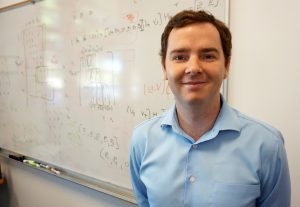By: Linda Fresques
 |
|
| David G. M. Mitchell, New Mexico State University College of Engineering assistant professor of electrical and computer engineering, is conducting research to make the world of 5G communication possible. (NMSU photo by Vladimir Avina) NOV17 |
The number of wireless devices connected to mobile networks is estimated to be three times the size of the global population by the year 2020. Smartphone traffic will exceed PC traffic. Global Internet traffic in 2020 is anticipated to be 95 times the volume of the entire global Internet in 2005. Some 250 million vehicles will be connected to the Internet and there will be 27 billion machines communicating with one another.
But will the technology be there to make it possible?
David Mitchell, assistant professor of electrical and computer engineering at New Mexico State University, is working to help meet those demands estimated by Cisco Systems Inc. Mitchell’s research is funded by a newly awarded, three-year National Science Foundation grant to develop technologies to enable the next generation of network communication known as 5G.
The success of 5G is viewed by some as a catalyst technology that will profoundly change our world, as did the advent of electricity, the steam engine and the telegraph. It is deemed also to be a source of sustained long-term economic growth, powering the “Internet of Things” – all of the physical devices and applications that require network connections to enable the collection and exchange of data.
“We have reached the fundamental limits of current technology. We will have to develop new technologies to meet the demand of next generation communication networks,” said Mitchell. “Along with the smart phones we have today, we will have smart cars, smart homes, biological sensors used in medicine, and all kinds of machine-to-machine applications that will rely on next-generation network communication.”
Wireless cellular communication began in the 1980s when 1G delivered analog voice, followed by 2G which enabled digital voice; 3G brought mobile data, and the current technology 4G LTE provides mobile Internet. 5G promises to expand mobile networks to support a wider range of devices and services, improve coverage, and should be faster, more efficient and reliable. 5G networks are expected to emerge in 2020.
Mitchell and his colleagues’ goal is to develop technologies with the ability to handle large amounts of data and to transmit that data quickly. They are focusing on novel methods for network users to work cooperatively, enabling more efficient connections within and between existing networks.
“The ground-breaking result would be to design schemes tailored to modern networks that can accommodate more data than ever before, and to do it faster and with more reliability,” said Mitchell.
Future generation communication systems are expected to be capable of handling 10,000 times more traffic than current 4G systems, with the time between transmission and receipt of communication being less than one millisecond.
“Broadband speeds will double. Video traffic is anticipated to make up 82 percent of Internet activity,” said Mitchell. “While streaming video is one important aspect, maintaining reliability for all types of applications is critical. For example, health care monitoring requires complete reliability and it needs to be immediately accessible.”
Not only will Mitchell’s research have technological impact, it will engage the next generation of researchers who will base their graduate studies on this project, which will encompass a number of fields, including circuits, signal processing and communications.
Mitchell and his colleagues are part of a huge effort led by academia, government and industry working to ensure that the expected demands of 5G cellular systems and beyond will be met.
“There is a huge number of different types of devices that will require this technology,” said Mitchell, adding, “There are a lot of problems that need to be solved to make it work.”
“Eye on Research” is provided by New Mexico State University. This week’s feature was written by Linda Fresques of the College of Engineering. Linda Fresques can be reached at lfresque@nmsu.edu.
